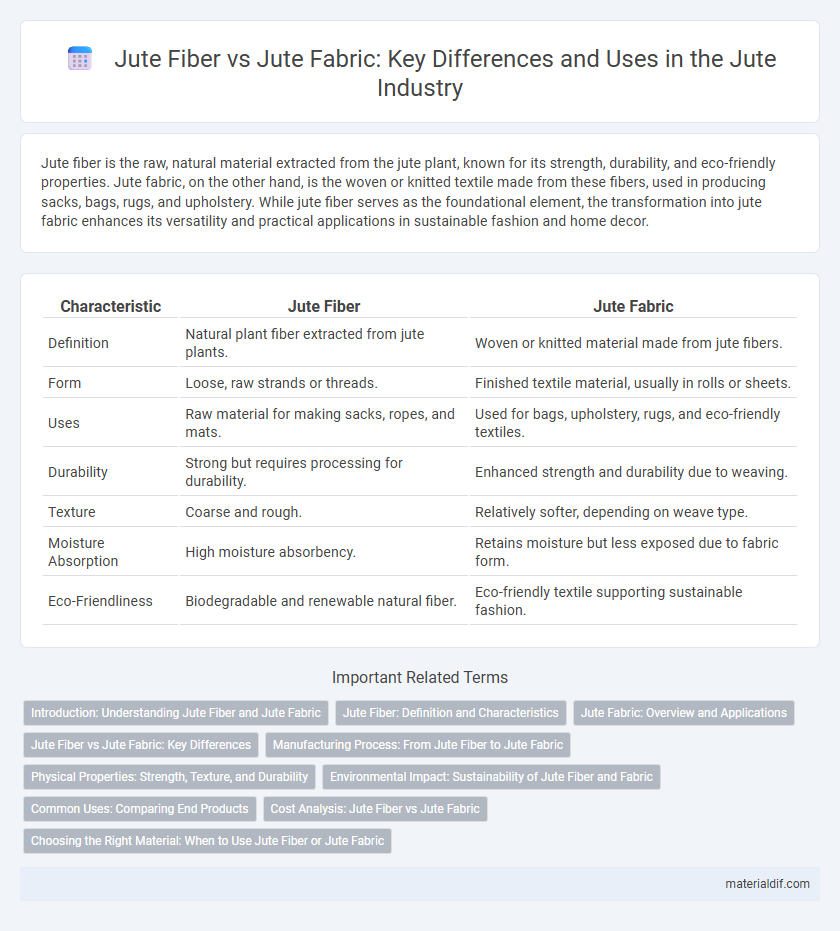Jute fiber is the raw, natural material extracted from the jute plant, known for its strength, durability, and eco-friendly properties. Jute fabric, on the other hand, is the woven or knitted textile made from these fibers, used in producing sacks, bags, rugs, and upholstery. While jute fiber serves as the foundational element, the transformation into jute fabric enhances its versatility and practical applications in sustainable fashion and home decor.
Table of Comparison
| Characteristic | Jute Fiber | Jute Fabric |
|---|---|---|
| Definition | Natural plant fiber extracted from jute plants. | Woven or knitted material made from jute fibers. |
| Form | Loose, raw strands or threads. | Finished textile material, usually in rolls or sheets. |
| Uses | Raw material for making sacks, ropes, and mats. | Used for bags, upholstery, rugs, and eco-friendly textiles. |
| Durability | Strong but requires processing for durability. | Enhanced strength and durability due to weaving. |
| Texture | Coarse and rough. | Relatively softer, depending on weave type. |
| Moisture Absorption | High moisture absorbency. | Retains moisture but less exposed due to fabric form. |
| Eco-Friendliness | Biodegradable and renewable natural fiber. | Eco-friendly textile supporting sustainable fashion. |
Introduction: Understanding Jute Fiber and Jute Fabric
Jute fiber is the raw, natural vegetable fiber extracted from the outer skin of the jute plant, known for its strength, biodegradability, and versatility in industrial applications. Jute fabric, on the other hand, is the woven or knitted material produced using jute fibers, commonly used in sacks, bags, rugs, and upholstery due to its coarse texture and durability. Understanding the distinction between jute fiber and jute fabric is essential for industries leveraging their environmental benefits and functional properties.
Jute Fiber: Definition and Characteristics
Jute fiber is a natural bast fiber obtained from the stem of the jute plant, primarily Corchorus olitorius and Corchorus capsularis, known for its strong, coarse texture and biodegradability. It exhibits excellent tensile strength, moisture retention, and breathability, making it ideal for sustainable packaging, rugs, and geotextiles. The fiber's lignin content and golden color contribute to its durability and aesthetic appeal in eco-friendly applications.
Jute Fabric: Overview and Applications
Jute fabric is a versatile textile made from the strong, natural fibers extracted from the jute plant, prized for its durability, breathability, and eco-friendly properties. Common applications of jute fabric include making sacks, bags, rugs, upholstery, and home decor items, where its biodegradability and cost-effectiveness offer significant benefits over synthetic alternatives. The fabric's coarse texture and high tensile strength make it ideal for industrial and agricultural uses, while recent innovations have improved its softness and aesthetic appeal for fashion and interior design.
Jute Fiber vs Jute Fabric: Key Differences
Jute fiber is a raw natural fiber obtained from the stem of the jute plant, primarily composed of cellulose, lignin, and hemicellulose, known for its strength and biodegradability. Jute fabric is a textile product made by weaving cleaned and processed jute fibers into durable, coarse cloth commonly used in sacks, bags, and home furnishings. The key differences lie in their form and usability: jute fiber is the unprocessed, fibrous material, while jute fabric is the finished, woven textile designed for practical applications.
Manufacturing Process: From Jute Fiber to Jute Fabric
Jute fiber is extracted from the bast of the jute plant through retting, stripping, and washing processes to obtain long, strong fibers ideal for textile production. These fibers undergo carding and spinning to form jute yarn, which is then woven or knitted into jute fabric using traditional or mechanized looms. The transformation from raw jute fiber to durable jute fabric involves precise control of moisture and tension, ensuring fabric strength and flexibility suitable for eco-friendly applications.
Physical Properties: Strength, Texture, and Durability
Jute fiber exhibits high tensile strength and coarse texture, making it ideal for durable rope and twine production. Jute fabric, derived from these fibers, maintains robustness while offering a softer, more flexible texture suitable for upholstery and sacks. The durability of both forms ensures resistance to wear and environmental factors, making jute a sustainable choice in various industrial applications.
Environmental Impact: Sustainability of Jute Fiber and Fabric
Jute fiber is a biodegradable, renewable resource with a low environmental footprint due to minimal water and pesticide use during cultivation. Jute fabric, made from this fiber, retains the sustainable properties, offering an eco-friendly alternative to synthetic textiles by reducing plastic pollution. Both jute fiber and fabric contribute to carbon sequestration and soil health, enhancing overall environmental sustainability.
Common Uses: Comparing End Products
Jute fiber is primarily used as a raw material in manufacturing ropes, sacks, and mats due to its coarse texture and high tensile strength. Jute fabric, derived from processed jute fiber, is commonly utilized in upholstery, curtains, and eco-friendly bags, offering a softer and more flexible texture. Both forms capitalize on jute's biodegradability and durability, but jute fabric caters more to textile and fashion industries while jute fiber serves industrial and agricultural applications.
Cost Analysis: Jute Fiber vs Jute Fabric
Jute fiber is the raw material, often priced lower due to minimal processing requirements, making it a cost-effective option for manufacturers focusing on basic applications. Jute fabric, however, undergoes spinning, weaving, and finishing processes, which increase production costs but add value through enhanced durability and versatility for end products. The price differential between jute fiber and jute fabric typically reflects these additional manufacturing steps and the broader market demand for finished textile goods.
Choosing the Right Material: When to Use Jute Fiber or Jute Fabric
Jute fiber offers unparalleled strength and biodegradability, making it ideal for industrial uses like rope and geotextiles where durability is crucial. Jute fabric provides flexibility and texture suited for home decor, upholstery, and fashion accessories, enhancing aesthetic appeal while maintaining eco-friendliness. Selecting between jute fiber and jute fabric depends on application requirements such as tensile strength versus visual appearance and comfort.
Jute Fiber vs Jute Fabric Infographic

 materialdif.com
materialdif.com